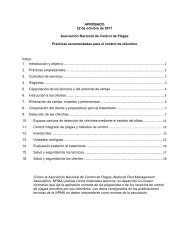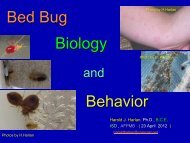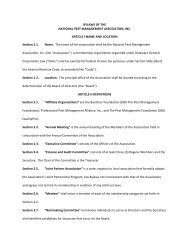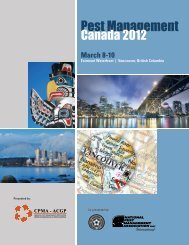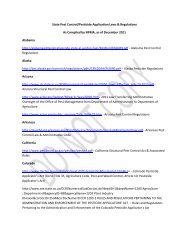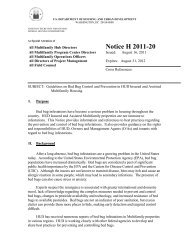guidance document - National Pest Management Association
guidance document - National Pest Management Association
guidance document - National Pest Management Association
Create successful ePaper yourself
Turn your PDF publications into a flip-book with our unique Google optimized e-Paper software.
Endangered Species LitigationImportant Guidance for California <strong>Pest</strong> <strong>Management</strong> Professionalsfrom the <strong>National</strong> <strong>Pest</strong> <strong>Management</strong> <strong>Association</strong>and the <strong>Pest</strong> Control Operators of CaliforniaJune 15, 2010The U.S. District Court for the Northern District of California recently approved an Orderand Stipulated Injunction restricting the use of 75 pesticides in eight San Francisco Bayarea counties to protect 11 federally listed threatened or endangered species. Thecounties include Alameda, Contra Costa, Marin, Napa, San Mateo, Santa Clara,Solano, and Sonoma counties and most rodenticides and termiticides are among therestricted pesticides. Click here to see the full list of restricted pesticides and thespecies identified in the Stipulated Injunction. (The use of pesticides indoors is notcovered by the Stipulated Injunction.)The Stipulated Injunction stems from a 2007 lawsuit filed by the environmental groupCenter for Biological Diversity alleging that the U.S. Environmental Protection Agency(EPA) failed to meet its obligation under the Endangered Species Act to consult with theU.S. Fish and Wildlife Service and <strong>National</strong> Marine Fisheries Service (Services). WhileEPA does assess the potential risk a pesticide poses to wildlife including threatenedand endangered species during the initial registration and reevaluation processes, it hasnot formally consulted with the Services when doing so, leaving it vulnerable tolitigation.The use restrictions for each active ingredient outlined in the Stipulated Injunction willstay in place until EPA completes its review and any necessary consultation with theServices regarding the potential effects of the active ingredient on the subject species.In the meantime, the interim protective measures are no-use buffer zones adjacent tocertain features within certain geographic areas in the eight counties. The buffer zonesare different depending on the species at issue and the pesticide being used.The <strong>National</strong> <strong>Pest</strong> <strong>Management</strong> <strong>Association</strong> (NPMA) and <strong>Pest</strong> Control Operators ofCalifornia (PCOC) expressed concerns about some of the restrictions included inthe original proposal EPA issued for public comment last summer. Some of the userestrictions outlined in the Stipulated Injunction adopted by the court, including the use
of rodenticides and termiticides and public health vector control programs are greatlyrelaxed from the restrictions that were originally proposed.EPA has developed maps to help applicators comply with the use restrictions. Thesecan be found at EPA’s Interim <strong>Pest</strong>icide Use Limitations Interactive Map. NPMA andPCOC continue to have concerns about the adequacy of the maps and continue tomeet with EPA to better understand and refine the maps. If the mapping is amended orrefined, we will notify you.The use restrictions are now in effect and will remain in effect until further order of thecourt. Commercial applicators who do not comply with these restrictions may be inviolation of a court order and could be subject to court imposed sanctions.General1. If you apply pesticides in Alameda, Contra Costa, Marin, Napa, San Mateo,Santa Clara, Solano, or Sonoma County, NPMA and PCOC recommend thatyou familiarize yourself with the use restrictions by visiting EPA’s website.2. Each of the 75 active ingredients listed in the Stipulated Injunction is subjectto use restrictions. Except for the rodent control, termite control and publichealth vector control exceptions discussed below, PMPs may not use a listedactive ingredient within the buffer zones established for that active ingredientin the Stipulated Injunction.3. A complete list of the affected pesticides is contained in Appendix A.4. The specific buffer zones in the counties referred to above can be found onEPA’s Interim <strong>Pest</strong>icide Use Limitations Interactive Map. Input an address orzoom in on the location where an application is to be made, then click on thelocation. On the right margin, there will appear a list of active ingredients thatmay not be used at that location.5. There are no use restrictions for the use of products inside structures.Rodent ControlExcept for brodifacoum, bromodialone, difenacoum and difethialone for which thebuffers on the SFB interactive map continue to apply, there are no buffers for use ofa pesticide for control of rodents adjacent to residential buildings (e.g., houses,apartment buildings, nursing homes, hospitals) or food handling, processing orserving establishments, provided:1. the pesticide is applied by a certified applicator certified in a category thatincludes the use of rodenticides; andJune 15, 2010
2. the pesticide is used in a tamper-resistant bait station deemed to be a Tier 1bait station according to the standards described in the “Risk MitigationDecision for Ten Rodenticides” (EPA May 2008); and3. the bait station is placed within ten feet of the structure.Subterranean Termite TreatmentThere are no buffers for use of a pesticide for subterranean termite control provided:1. the pesticide is applied by a certified applicator certified in a category thatincludes the use of subterranean termite control products; and2. the product is used within 10 feet of the structure being treated for termites.Public Health and Vector Control ProgramsThere are no buffers imposed when:1. the pesticide is used as part of a public health vector control programprovided such program is administered by public entities; or2. the pesticide is used by a certified applicator for control of a vector pest whensuch control is necessary to respond to a federally or state-declared publichealth emergency.Members that have questions or need additional information should contact NPMA at(800)678-6722 or PCOC at (916)372-4363.June 15, 2010
Appendix A<strong>Pest</strong>icides Covered by the Stipulated Injunction(Products commonly used by PMPs are listed in bold font)2,4-Dacephateacroleinalachloraldicarbaluminum phosphideatrazineazinphos-methylbensulidebeta-cyfluthrinbifenthrinbrodifacoumbromadiolonebromethalincarbarylcarbofuranchlorophacinonechlorothalonilcholecalciferolchlorpyrifoscyfluthrincyhalothrin(lambda)cypermethrindeltamethrindiazinondifenacoumdifethialonedimethoatediphacinonedisulfotondiquat dibromideendosulfanEPTC (eptam)esfenvalerateethopropfenpropathrinfipronilfluvalinateimidaclopridmagnesiumphosphidemalathionmanebmancozebmetam sodiummethamidophosmethidathionmethomylmethoprenemethyl bromidemetolachlornaledoryzalinoxydemeton-methyloxyfluorfenPCNBpendimethalinpermethrinphenothrinphosmetphoratepotassium nitratepropargiteresmethrins-metolachlorsimazinesodium cyanidesodium nitratestrychninetetramethrinthiobencarbtralomethrintrifluralinwarfarinzeta-cypermethrinzinc phosphideJune 15, 2010




